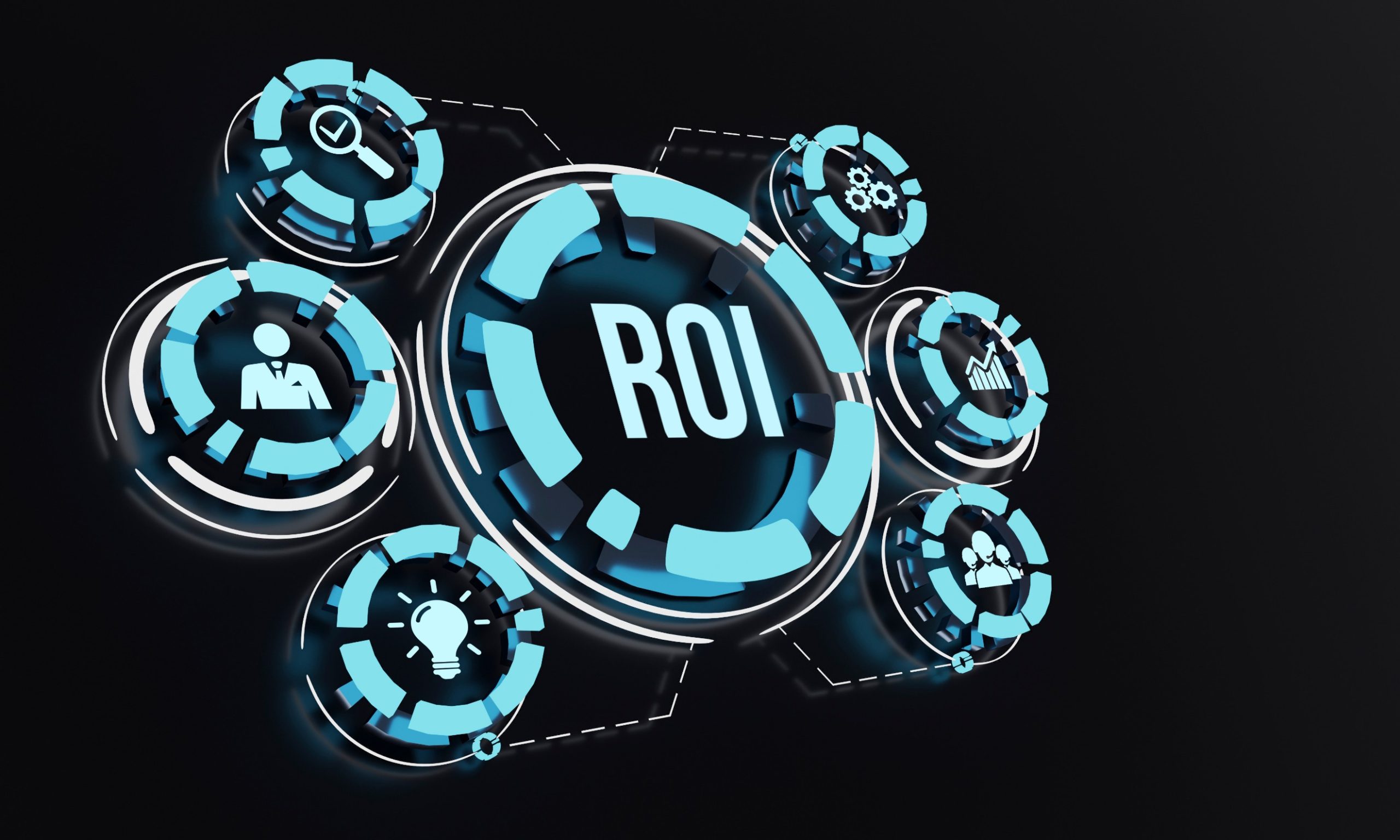In the fast-paced world of event marketing, understanding the true impact of your efforts is crucial. Whether you’re organising a small conference or a large-scale trade show, measuring event ROI is the key to unlocking the full potential of your events. But event ROI goes beyond simply calculating revenue; it’s about measuring your event’s comprehensive value, from brand recognition and lead generation to attendee satisfaction and media coverage. This article will take you through the essential steps to measure and optimise event ROI, ensuring your events meet and exceed expectations.
What is event ROI?
A versatile phrase known as “event ROI” describes the net value that an event marketer receives from an event relative to the net cost of organising it. Keep in mind that the phrase “value” is far more inclusive than “event revenue.” While “value” might refer to the money made from registrations, it could also refer to partnerships and sponsorships, leads added to the sales funnel, attendance figures, attendee happiness, and more.
Comparably, the “cost” of an event might refer to the money spent on its production, but it could also mean the resources and time invested, the missed opportunities associated with hosting the event, and so on.
Value Factors in Event ROI
Event Revenue

Most events’ primary source of income is registration fees or ticket sales. This revenue stream is often the most straightforward to track and quantify, making it a key indicator of the event’s financial success. Beyond covering costs, high ticket sales can also reflect the perceived value of the event, indicating strong demand and interest from the target audience.
Lead Generation
Events offer a prime opportunity to discover new prospective clients or customers. By capturing contact information and gauging interest levels during the event, businesses can expand their sales funnel with fresh leads. The quality and quantity of these leads can significantly influence the long-term return on investment (ROI), as they represent potential future revenue.
Pipeline Value
Beyond immediate sales, events can serve as a catalyst for future commercial agreements. The relationships and connections forged during an event often lead to business deals that materialise over time. Assessing the potential value of these prospective agreements provides a more comprehensive understanding of the event’s impact on the company’s bottom line.
Number of Attendees
Attendance figures are a crucial metric in evaluating an event’s success. More attendees typically correlate with increased reach, impact, and revenue. Additionally, a large crowd can enhance the event’s atmosphere, making it more appealing for future participants, sponsors, and partners.
Sponsorships and Partnerships

Collaborations with sponsors and partners can significantly enhance an event’s value. These relationships may offset costs through financial contributions or in-kind support, add credibility, and attract additional attendees. The long-term benefits of these partnerships often extend beyond the event itself, fostering ongoing collaboration and mutual growth.
Brand Recognition
Expanding a brand’s reach is critical for many events, particularly those targeting new markets or demographics. Successful events can elevate brand visibility, making it more recognisable and trusted among new audiences. This increase in brand recognition can translate into higher customer loyalty and sales in the long run.
Social Media
Media coverage and social media engagement can amplify the event’s reach far beyond its physical attendees. Positive press mentions and active social media sharing by participants and partners increase visibility and contribute to brand awareness. This digital footprint can create a lasting impression, drawing attention from potential customers who still need to attend the event.
Content Creation for Marketing
Events are a goldmine for content generation, providing material that can fuel marketing efforts for months. Businesses can create promotional videos, blogs, and social media posts by capturing client testimonials, recording sessions, and taking high-quality photos. This content extends the event’s life and enhances the company’s marketing arsenal, supporting ongoing campaigns.
Cost Factors in Event ROI
Transport expenses for speakers, staff, VIP attendees, and organisers can quickly add up, especially for international events. These costs are essential to consider, as they directly impact the overall budget and can influence the choice of event location.
Flights and Travel
Lodgings
Accommodations for speakers, staff, and VIP guests are another significant expense. The quality and convenience of lodgings can also affect the experience and satisfaction of key participants, making it an essential factor in the event’s success.
Swag
Gifts or promotional items, often referred to as swag, are popular ways to enhance the attendee experience and promote brand recall. While these items can increase the event’s appeal, they also contribute to the overall cost, necessitating careful budgeting and selection to ensure a good ROI.
Labour
The human resources required to plan, manage, and execute an event represent a substantial investment. This includes the hours spent by internal teams, external contractors, and volunteers. The effectiveness and efficiency of the labour force directly impact the smooth execution of the event and its overall success. Organisations often use tools like HR software to streamline workforce management, track hours, and allocate resources effectively, which can help optimise event planning and reduce costs.
Time
Time is an often-overlooked cost in event planning. The time to organise an event could have been spent on other revenue-generating activities. This opportunity cost must be factored into the ROI calculation to understand the event’s value fully.
Catering
Food and beverage costs are a major component of the event budget, particularly for events with large attendees or multiple meal functions. Quality catering can significantly enhance the attendee experience but also requires careful planning to balance costs and expectations.
Event Booth or Stall
Setting up an informational or promotional booth at an event involves direct costs (such as materials and setup fees) and indirect costs (such as staff time and effort). The design and location of the booth can influence its effectiveness, making it a critical consideration in the overall event strategy.
Extra Experiences
Additional activities, such as happy hours, off-site excursions, or special entertainment, can greatly enhance the attendee experience and add to the event’s expenses. These experiences can differentiate an event from its competitors, making it more memorable and appealing, but they must be carefully weighed against the added costs.
Importance of Evaluating Event ROI
Measuring event ROI is a strategic investment that drives growth, transparency, and continual optimisation. It helps:
Quantify Value and Impact
Evaluating event ROI allows organisations to quantify the value and impact of their events. By analysing hard metrics such as revenue, lead generation, and brand recognition, companies can justify the investment and resources required to stage events. This quantification helps make informed decisions about whether the event met its objectives and delivered the expected return.
Drive Strategy
Analysing ROI provides valuable insights into what’s working well and where there is room for improvement. These data-driven insights are essential for refining strategies and ensuring that future events are more effective. Organisations can tailor their approaches to better align with their goals by identifying successful elements and areas needing adjustment.
Strengthen Stakeholder Buy-In
ROI metrics play a crucial role in reporting to stakeholders, whether they are company leadership, investors, or partners. Providing concrete evidence of an event’s success strengthens stakeholder buy-in and ensures continued support for future events. This transparency in reporting helps build trust and secures the necessary resources for future initiatives.
Focused Budget
Tracking ROI is essential for effective budget management. Organisations can allocate their budgets more wisely by understanding which activities generate the highest ROI. This focus on high-ROI activities optimises spending, leading to better outcomes without unnecessary expenses.
Allow Benchmarking
Comparing ROI across different events enables organisations to identify trends and measure progress over time. Benchmarking helps set realistic goals and manage growth by clearly showing what has been achieved and what can be improved. This continuous comparison is key to maintaining and enhancing the effectiveness of event strategies.
Maximise Future Success
Evaluating ROI creates an opportunity for learning and improvement. By analysing the results of past events, organisations can identify what worked well and what didn’t, paving the way for better ROI on future events. This iterative process of assessment and refinement ensures that each event builds on the successes and learnings of the previous ones.
Build Transparency
Conducting a thorough ROI analysis communicates an event’s financial health clearly to stakeholders. This transparency demonstrates accountability, showing that the organisation is committed to using its resources effectively. Clear communication of ROI also fosters a culture of continuous improvement, where everyone involved understands the impact of their efforts.
Measuring Event ROI: 7 Most Important Metrics
Attendance rate
The total number of persons who visited your booth divided by the total number of trade show registrations yields the attendance rate. It is crucial to measure this for several reasons, the first of which is that it provides insightful information about the general attractiveness of the trade show and the success of your company’s exhibit.
Engagement rate
Tracking event engagement can help you see how well you interact with your target audience. A high engagement rate is a positive indicator of more productive talks and relationship-building since it shows that your booth draws in and keeps people’s interest.
The kinds of activities and calls to action that your company will carry out for the event will determine the event engagement metrics. However, the following are typical metrics that you may monitor:
- The number of queries posed
- Participation rate at seminars, in-person product launches, and presentations
- quantity of downloaded apps
- Total number of contestants
By monitoring interaction, you can improve your strategy, customise your messaging, and maximise your trade show participation. This will increase the likelihood that leads will become sales.
Lead generation
Lead generation success during an event may be assessed by looking at the number and quality of leads produced. First, you may compare the number of new leads added to the database to your determined benchmarks to gauge progress.
But lead quality matters just as much, if not more. Determine how well these leads match your buyer profile or target audience and how interested they are. In addition to producing a sizable number of fresh leads, a successful lead generation event should also make a high proportion of leads with the potential to become customers. This can be determined by monitoring the leads’ level of engagement and responsiveness to your marketing and follow-up messages after the event.
Social media engagement
In order to maximise your reach and influence, as was discussed earlier, you must promote the event both before and during the trade show. To evaluate social media participation during the event, keep an eye on these metrics:
- Friends and followers on your postings about events
- Likes and shares in event-related posts
- Comments on and questions about your posts on the event
- Gained new social media fans following the occasion
- Number of social media mentions of the brand and hashtag
- Conversations on event hashtags
Total cost of the event
Determining an event’s overall profitability requires calculating its total cost. This amount should include all expenditures, including personnel, promotion, venue rental, and food. Event planners like you can calculate the possible return on investment and make data-driven decisions for future events by calculating the total cost.
Customer satisfaction
Post-event surveys and feedback gathering assess client satisfaction following trade fair events. Distribute surveys to participants at the trade event, such as exhibitors or partners. Enquire about their experience, the benefits they received, and their level of happiness with the event in these surveys.
To get thorough input, use both open-ended questions and numerical rating systems. Examine the survey data to determine the most important development areas and obtain information on improving participation in upcoming trade shows. Monitor social media and internet mentions of the event to get a sense of the mood and collect uninvited opinions. By combining these techniques, you can efficiently measure and raise customer happiness.
Media coverage
Events are a great opportunity to stand out and create a stir! However, assessing their influence and reach is crucial. Measuring media coverage is one way to address this.
Keep note of news articles, press releases, and other forms of publicity to assist you in determining the degree of success of your event. Thanks to the knowledge you acquire, you’ll be able to hit the mark the following time.
What is the role of event technology in ROI?
Event ROI analysis requires the use of event technology. It ensures a thorough ROI analysis by streamlining the process of computing event ROI and offering a complete, data-driven perspective on numerous event components.
Event Analytics
Event technology serves as the foundation for ROI calculation. With event technology, planners can obtain statistics on attendee engagement, session popularity, and interaction levels both during and after the event. These statistics make it easier to identify your strengths and opportunities for development.
Event success metrics
The use of appropriate technology makes it easier to identify important event performance indicators. Metrics like attendance, session participation rate, and app engagement during an event are examples of this.
Cost-benefit analysis
Event technology streamlines the process of conducting cost-benefit analyses by enabling organizers to compare an event’s financial benefits with its non-financial advantages. This understanding is essential to properly calculating event ROI.
Event revenue generation
Sophisticated event systems can track income streams, including ticket sales, sponsorships, and even on-site transactions, to obtain an accurate image of the event’s financial performance.
Attendee satisfaction
Event technology allows for measuring attendee satisfaction using feedback tools and post-event evaluation questionnaires. This information provides an overall event experience, which is important for calculating return on investment.
Event marketing impact
Event management systems can measure metrics such as email open rates, social media engagement, and registration conversions to track the effectiveness of event promotion. By being aware of this effect, marketing methods may be improved for a higher return on investment.
Post-event evaluation
Event technology allows you to carry out an exhaustive post-event analysis, which is essential for determining the event’s overall success, honing your future event tactics, and increasing return on investment.
Wrap up
Ultimately, evaluating event ROI is more than just crunching numbers; it’s about understanding the full scope of your event’s impact. By carefully measuring both the value created and the costs incurred, you can gain deep insights into what works and what needs improvement. This holistic approach helps justify the investment and refines strategies for future events. With the right tools, metrics, and mindset, you can transform your events into powerful engines of growth and success, ensuring that each one delivers even greater ROI than the last.




